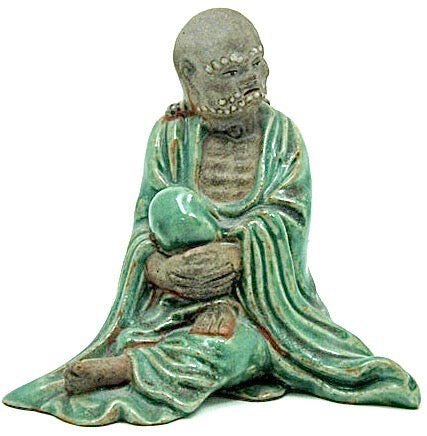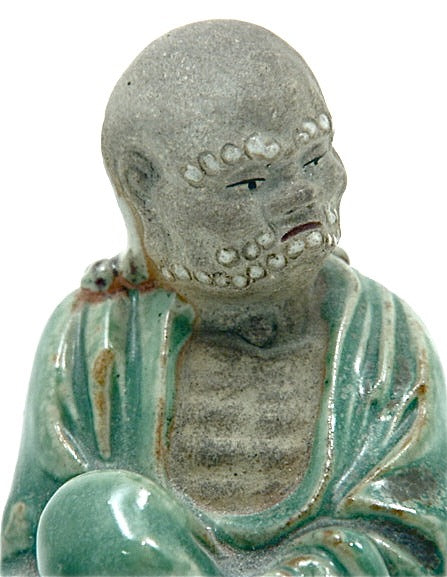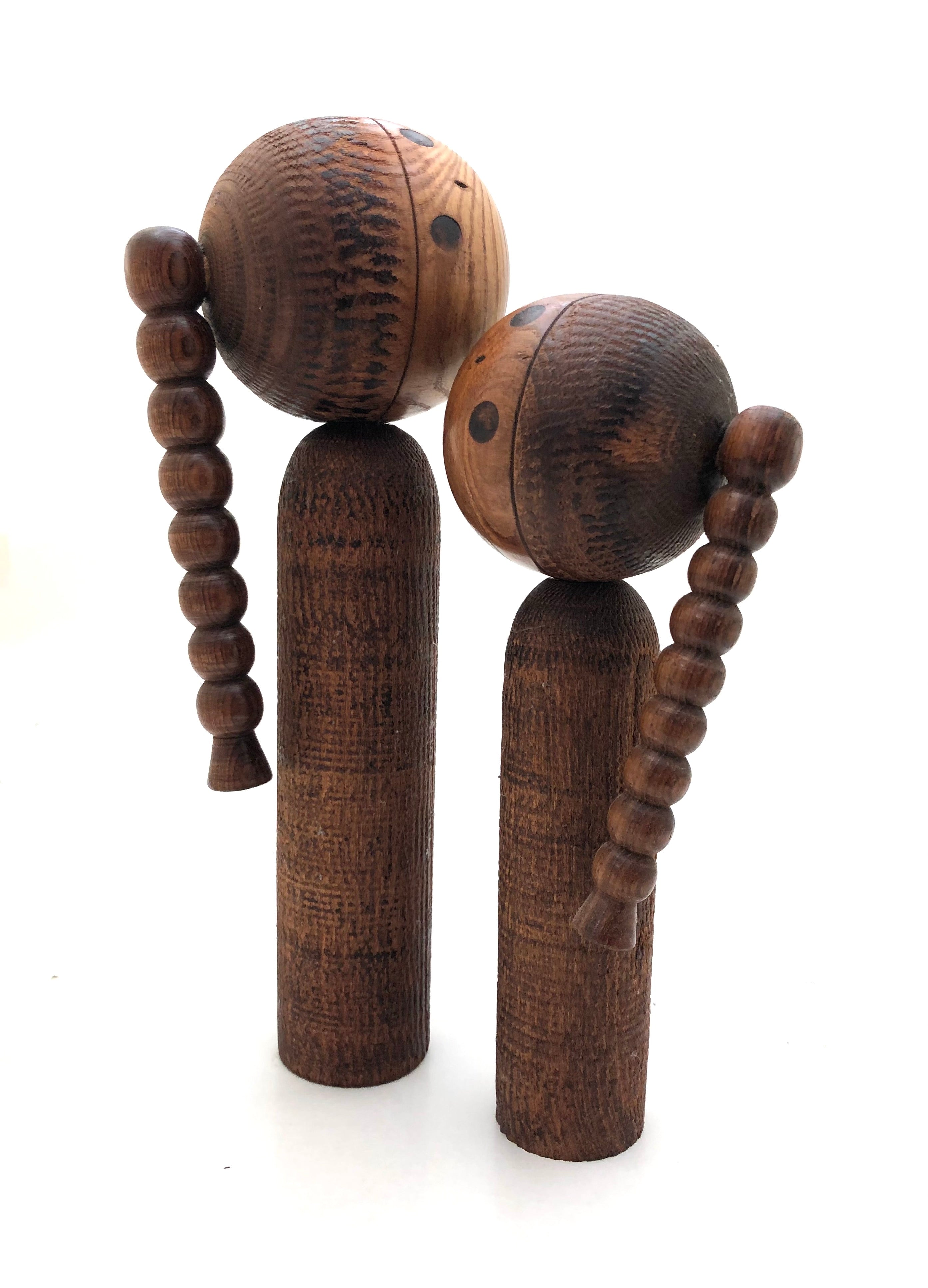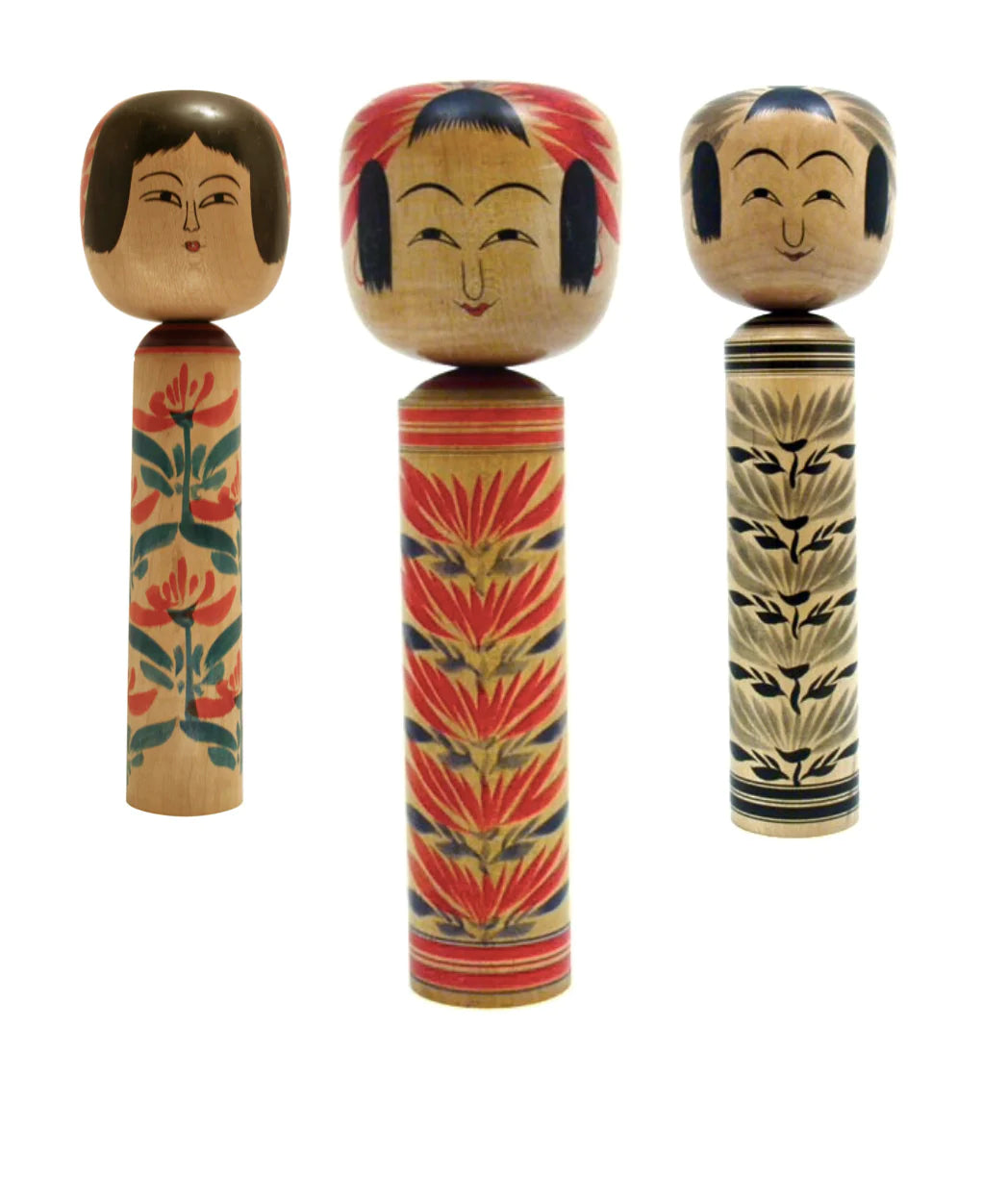



Antique Chinese Shiwan Pottery | Lohan
Dimensions: 5-1/2”w x 4-1/4”d x 5-1/2”h
This exceptional mud figure is beautifully glazed in a rust-colored base that shows through to the celadon outer glazing on his robe. It is beautifully detailed with its natural folds. His feet, (one leg pulled up over his left leg and held by both hands), detailed hands, chest, which shows his ribs as that of an ascetic, (a person who practices severe self-discipline and abstention), and expressive face/head are unglazed. The most exceptional features are his beard and eyebrows. They are glazed in white and shown as small “dots” outlining their shapes and giving an exceptional texture to the face. His facial expression suggests he is in a contemplative mood. The figure has an incised seal of Wen Zhongling and was made between 1900-1920. This piece is from the Estate of Rudolph Schaeffer, (1886-1988) who headed the School of Art & Design in Chinatown & Potrero Hill San Francisco which closed in 1984. He had a large collection of Chinese artifacts, particularly Shiwan Art pottery. Because of its age and rarity, few are found in museums outside of China, and most are held in private collections in both that country and abroad.
Arahat, translated in Chinese as Lohan, is an important figure in the Buddhist religion. There were originally only 18 Lohans, each added throughout the evolution of the Chinese dynasties), and were introduced into China from India around the 1st/century A.D. It is said that Lohan supposedly moved through all the stages of the Buddhist ‘eightfold path’, and he conquered all the desires that enmesh a person in the continuous cycle of birth and death, and hence will no longer be reborn. He is regarded as a type of saint who has already attained Nirvana and is attributed to supernatural powers. Lohan was thought to collect all the relics of Buddha, built a splendid pagoda to house them, and then vanished into Nirvana.
Condition: Excellent meaning that the piece retains its original craft/workmanship showing a wonderful-developed patina commensurate which suggests a degree of wear that corresponds to its vintage and meets all the standards of the collectible Shiwan ware. No discoloration, chipping/cracking, surface wear, or structural damage.
Additional Information: As an important part of Chinese traditional culture, ceramic wares have a long history reflecting the customs of this ancient culture. One of the most famous types of ceramic works is called Shiwan (Shekwan) ware, which has been the shining star in Chinese folk ceramic art as early as the Tang and Song Dynasties (618-906AD), and which flourished in the Ming and Qing dynasties.
Chinese Classical Shiwan ware is a type of traditional pottery that comes from the talented artists of a small town located in the south of China called Shiwan, in Foshan City, famous for its culture and pottery. Here craftsmen are well-known for their glazing techniques and unique forms. All the sculptural work is hand-formed, and sometimes involves numerous family members within a village, while directed by a master craftsman, every object is unique, and therefore, a limited edition, which attracts art collectors the world over. The three largest collections of Shiwan Art Pottery are housed in the Hong Kong Fung Ping Shan Museum, and the Chinese Cultural Centre in San Francisco.
Original Shiwan figurines, (1880-1940), are extremely rare because of their art/craftsmanship and their delicate, fragile nature. The greater the detailing, the more likely the figure has been made by a master artist, hence the higher value. Also the larger the piece the more valuable, (8-0” or pieces over 20.0” tall) are extremely rare. The age of Shiwan ware can be verified by the markings, or lack of markings, the fact that they are hand-formed, depicting highly expressive figural forms and vivid imagery; primitive in sculpting techniques; the decorative elements associated with the figure; the deep rich glazes infused with the piece; the type of regional clay (sandy, coarse clay is the oldest), and the stylistic differences. Travelers or missionaries to the orient would purchase the mud figures at local markets and carry them home. These were not stamped, because they were not for importation, although you may find some pieces signed by the artist.
Return Policy
Our antique/vintage pieces are identified/described and professionally photographed, and considered, “as is”, therefore all sales are final. Read our full refund and return policy.


